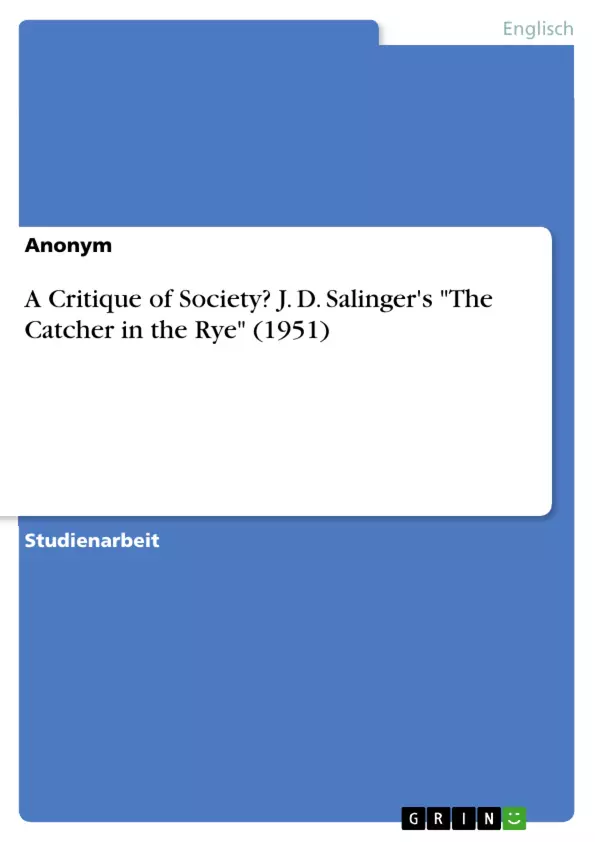Having read "The Catcher in the Rye" one really feels like understanding the protagonist, Holden Caulfield. It seems like J.D. Salinger succeeds in depicting the problems of a 16-year-old boy in a post-World War II setting. He captures “the pressures and tensions of prep school life, the confusions of late adolescence, the quest for a vaguely defined religious purity, or the contradictions that result when its protagonist too neatly divides the world into phonies […] and the pure spirit.” (Pinsker XV)
It is one of the best selling books of all time selling “more than 60million copies worldwide and has remained a stalwart on school curricula since it was published in 1951.“ (Longbottom) I think the reasons for its success are clear; adolescents from today still can identify with Holden’s confusion with the adult world and his angst of growing up and changing.
The novel was a highly controversial book from the day it was first published in 1951. It was banned in many countries and taken of the reading list from many schools. People who tried to ban the book often argued with the books language and said that its message was “trash” (Pinsker 35) as the following excerpt of a letter Edward B. Jenkinson, a teacher and book author, received from an upset parent shows: “’You call yourself a Christian, but you’re an atheist, a communist, and a smut peddler. Why do you insist on having children read four-letter words in school? Why do you want to fill their minds with trash? Why do you want to destroy America’s children?’” (Pinsker 35)
Is Salinger’s The Catcher in the Rye a critique of the society surrounding Holden? That is the subject matter of this paper concerning preparatory schools, the dishonesty of adulthood, some important characters and the Museum of Natural History as depicted in the novel The Catcher in the Rye by J.D. Salinger.
Inhaltsverzeichnis
- Introduction
- Preparatory Schools
- Definition
- How Pencey Prep is being portrayed
- Why Prep School?
- Dishonesty of Adulthood
- What is "phony" to Holden?
- Is Holden right?
- Important Characters
- Sally Hayes
- Phoebe Caulfield
- Museum of Natural History
Zielsetzung und Themenschwerpunkte
Dieser Essay analysiert J.D. Salingers The Catcher in the Rye und untersucht, inwieweit der Roman eine Kritik an der Gesellschaft darstellt, die Holden Caulfield umgibt. Der Essay konzentriert sich auf die Darstellung von Vorbereitungsschulen, die Heuchelei des Erwachsenenlebens, wichtige Figuren und das Museum für Naturgeschichte im Roman.
- Die Darstellung von Vorbereitungsschulen und ihre Rolle bei der Hervorhebung der Ungleichheit in der amerikanischen Gesellschaft.
- Holdens Suche nach Authentizität und seine Wahrnehmung der Heuchelei des Erwachsenenlebens.
- Die Bedeutung wichtiger Figuren wie Sally Hayes und Phoebe Caulfield für Holdens Entwicklung.
- Das Museum für Naturgeschichte als Symbol für Holdens Sehnsucht nach Unveränderlichkeit und Unschuld.
- Die Kontroversen, die The Catcher in the Rye seit seiner Veröffentlichung ausgelöst hat.
Zusammenfassung der Kapitel
Die Einleitung bietet einen Einblick in die Komplexität von The Catcher in the Rye und beleuchtet die Rezeption des Romans. Sie stellt die zentralen Themen des Essays vor, die sich auf die Kritik an der Gesellschaft, die Darstellung von Vorbereitungsschulen und die Bedeutung wichtiger Figuren konzentrieren.
Der Abschnitt über Vorbereitungsschulen analysiert die Darstellung von Pencey Prep und die Kritik an der elitären Bildungseinrichtung. Er beleuchtet die Rolle von Vorbereitungsschulen bei der Hervorhebung der sozialen Ungleichheit und untersucht Holdens negative Erfahrungen an dieser Schule.
Der Abschnitt über die Heuchelei des Erwachsenenlebens befasst sich mit Holdens Wahrnehmung der Erwachsenenwelt und seiner Suche nach Authentizität. Er untersucht, was Holden als "phony" betrachtet und hinterfragt, ob seine Kritik gerechtfertigt ist.
Der Abschnitt über wichtige Figuren stellt Sally Hayes und Phoebe Caulfield vor und analysiert ihre Bedeutung für Holdens Entwicklung. Der Essay beleuchtet die Beziehungen zwischen Holden und diesen Figuren und untersucht, wie sie seine Sicht auf die Welt beeinflussen.
Der Abschnitt über das Museum für Naturgeschichte untersucht die symbolische Bedeutung des Museums für Holden. Er analysiert, warum Holden das Museum als Ort der Unveränderlichkeit und Unschuld schätzt und wie es seine Sehnsucht nach einer Welt ohne Veränderung widerspiegelt.
Schlüsselwörter
The Catcher in the Rye, J.D. Salinger, Vorbereitungsschulen, Heuchelei, Jugend, Authentizität, Unschuld, Kritik an der Gesellschaft, soziale Ungleichheit, amerikanische Kultur, Coming-of-Age-Roman.
- Citation du texte
- Anonym (Auteur), 2013, A Critique of Society? J. D. Salinger's "The Catcher in the Rye" (1951), Munich, GRIN Verlag, https://www.grin.com/document/295468



